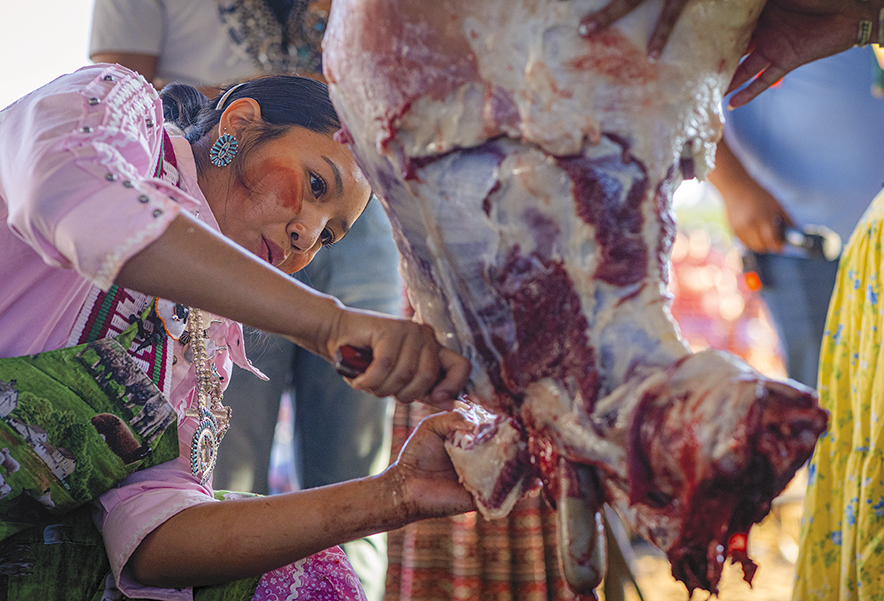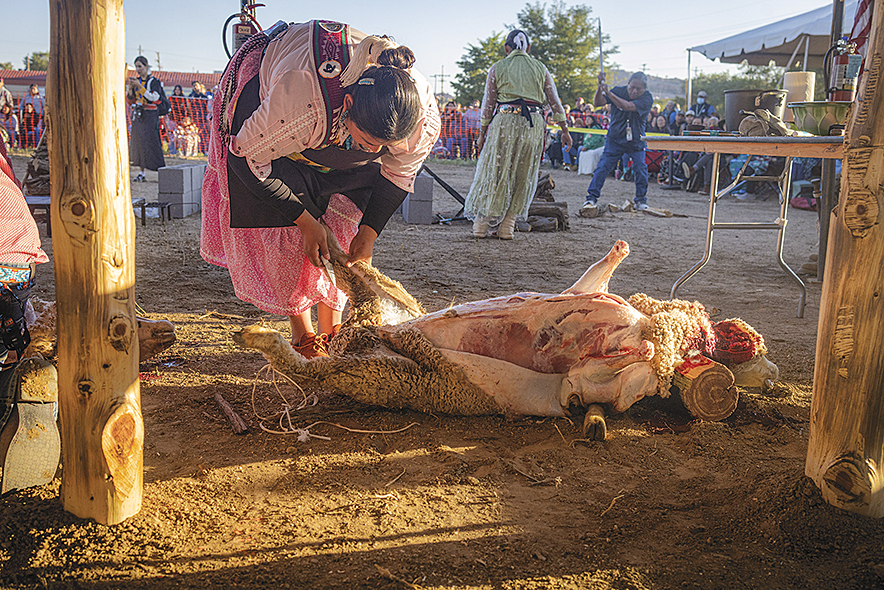
Ná’á’ah: Six Diné women complete coveted sheep-butchering competition

Special to the Times | Sharon Chischilly
Miss Navajo Nation Niaomi Ranae Benally, wearing chííh on her face, uses a béésh to cut the ‘ajéíts’iin during the Miss Navajo Nation sheep-butchering competition on Monday morning outside NACE in Window Rock.
By Nicholas House
Navajo Times
WINDOW ROCK – She wore chííh as she removed the dibé bikágí.
The chííh representation was not to intimidate her competition, but to honor her clan lineage, the Tł’ááshchí’í, she said. The chííh is not a usual practice in ná’áł’ah.
“It’s the chííh I made at my kinaaldá. One of the (clan) stories, people would see the Tł’ááshchí’í people and people would be like they’re intimidating, but that’s not how I wanted to present myself. It’s just how my clan is and the stories behind it,” said Niaomi Ranae Benally, 18, who’s one of six Miss Navajo Nation pageant contestants. Benally is contestant No. 1 in the prestigious pageant.
Sheep-butchering day
The six contestants were silent as the emcee.
Ranisha Chrislyn Begay, 23, incorporated her butchering skills from her mother’s father and her father’s mother.

Special to the Times | Sharon Chischilly
Miss Navajo Nation Quandinna Cheyanne Begay, 23, removes the sheep hide during the Miss Navajo Nation sheep-butchering competition on Monday morning outside NACE in Window Rock.
“On my mom’s side, I have my cheii who taught me,” Begay said, “and on my dad’s side I have my nálí asdzą́ą. She taught me. And it’s funny because they both have different perspectives on how they do thing.” “One important thing to know is: go with what you know,” Begay explained. “Present what you know and continue to practice it, and you’ll get better”
Kiana Omi Toadlena, contestant No. 3, background in sheep-butchering was different than the contest. “Traditionally, butchering sheep requires family. I was always taught that when you’re butchering sheep, we’re all supposed to help, and no one is supposed to do it by themselves. So, getting over that teaching growing up was a little tough for me, for this competition,” Toadlena said.
Toadlena learned sheep-butchering from her grandfather, Aaron Toadlena, and her sister’s family in-law. “Traditionally, we’re taught that we’re not supposed to butcher a lot,” Kiana added.
Family orientated, Toadlena used her family’s tools. “I used a lot of family members’ knives. They offered to buy me a whole new set,” she said. “I thought it would mean more to use my uncle’s knives, my grandpa’s, my dad’s––just different knives from different family members.”
Toadlena brought her kinaaldá hair tie to remind herself of her kinaaldá. “When I was going through my kinaaldá, it was tough to get through. So, ever since then I always say, ‘From my kinaaldá.’ If I can do that, I can do anything. So, kinda catering my dream of being Miss Navajo, I’m reassuring my younger spirit.”
During the contest Toadlena cut her left middle finger and got a skin burn on her right inside arm. At the last minute she was asked to stop to have her cut finger checked by the med team. She stepped away and came back after to continue her task to butter with the remaining time she had left.
Dayhenoa Ch’ikeeh Nizhoonii Yazzie’s fundamentals of butchering is a strong support system to butcher a sheep. “I believe that it takes a very strong support system,” she said. “You may not have a large family or just have one or two to teach you to butcher a sheep.
“If that person supports you and believes you and has the upmost love for you, that’s what it takes to butcher and to learn,” she said. “As well as yourself. Your open-mindedness and willingness to learn.”
“In the way that our people butcher they say, ‘tsxłígo,’ they got on you to hurry and be quick,” Yazzie explained. “And that’s the teaching. It has a lot to do with how you butcher, because once things (meat) get dry, it’s hard to cut.
“And really that’s why they tell you to hurry. ‘Tsxłígo shiyázhí or hold this, hold that, fast, be strong, do things quickly,” she added. “They sound like they’re getting after me; they’re actually not they’re teaching within what they were taught for generations.”
She learned to butcher from her mother’s sister, Wandra Kenny, a second-generation food provider at the Kayenta flea market. Kenny makes her living solely by her food sales. Yazzie would join Kenny every weekend to butcher for preparation of the contest and carry her aunt’s knowledge of butchering to the next generation in her family. Yazzie smiled and said, “I remember she would always tease me, because I would have the hardest time trying to cut through the bone and she would tell me, ‘You need to wake up and do pushups and make sure you do sit ups.”
Yazzie gave insight that during her weekends with Kenny, she would see her butcher an entire sheep in around 30 minutes by herself. “Really the story behind that is because her family have been serving (sheep) at the flea market for half a century now,” Yazzie. “Her mom and her dad served at the flea market and that business was passed down to her. I’m fortunate to learn from her.”
Yazzie highlighted that butchering is Kenny’s way of life. “She butchers and feeds the community of Kayenta and surrounding communities,” Yazzie said. Sometimes Kenny doesn’t have to help butcher. Yazzie extended her gratitude of learning from her aunts’ teachings and perspectives and her life’s stories.
In the beginning of the contest Yazzie practiced her teaching of tapping the sheep with twine for a good butcher.
Kenny told Yazzie, “I’m happy you asked me (how to butcher) because now I can pass down this knowledge and continue to share it. That is something my (late) mom and (late) dad wanted from me to share that with you. I am happy to have been that person (to teach).”
Yazzie explained her time of learning was also a time of healing for Kenny, who lost both of her parents.
Yazzie was most excited to showcase her butchering skills out of other pageant competitions as this is where she would show her mother and aunt’s teachings.
Yazzie’s teachings kept her mindful of being positive because with food we are replenishing and rejuvenating the ones we feed.
Taneesha Francis, the first to complete the butchering from the contest, said it takes a lot of confidence, strength and determination to take the test of butchering. “My family told her always to be strong when I’m butchering a sheep,” Francis started. She learned how to butcher from her mom and a family friend: her Uncle Larry. She helped attend her family’s flock of around 80 sheep. Her family would butcher from time to time, and she would be asked by her mom, Thomacina Francis after her mom would pick a sheep.
A week before the contest she went to her sheep to get a headcount. She questioned where her sheep had gone or if the person in charge of watching her sheep lost them. Her mother told her, “You butchered them.” Taneesha was surprised. She said she butchered about 10 sheep to prepare for this contest. In the beginning of her preparation, she said the hardest part of the butchering was taking apart the rear. But quickly got it as she practiced.
Francis said she was excited for the contest when asked if she was nervous. She had her lucky pins given from her family members.
Francis advised it’s best to stay calm while butchering.
Quandinna Cheyanne Begay, learned how to butcher from her grandparents and family. She was raised by her grandparents who cheered and aided her in teaching in butchering.
Begay didn’t decide to run until late February, so her family had participated in n’dáá they could build her experience even further.
Begay wore her mother, Raytanya Yazzie’s pin as good luck. “All of the stuff I am wearing, belonged to my family. And that’s who I carry with me through this,” Begay said.
Begay, said she was nervous, “It’s such a big competition. The nerves are there.”
During the contest, Begay cut her finger trying to cut sternum and the knife slipped. Begay was sent to the hospital and got three stitches. Valentina Clitso, the Miss Navajo Nation 2022-23, stepped in and finished where she left off. Begay returned and did the traditional foods competition.
Begay said, “I feel bad I didn’t get to finish. But yang as they say safety is the number one priority.”
Throughout the morning, the ash from the kǫ’ fell over the contestants, judges, and the visitors. As the judges walked and spectated carefully, they threw questions in Navajo to the women: attending to their fires, sectioning their sheep skillfully with their knives, protecting their eyes from the smoke and ash.
The six Miss Navajo contestants brought their butchering and traditional cooking skills to the table.
Navajo Arts and Craft Enterprise hosted and sponsored the butchering and traditional foods competition behind their store, which is in Window Rock, off State Highway 264.








 Highway 264,
Highway 264, I-40, WB @ Winslow
I-40, WB @ Winslow